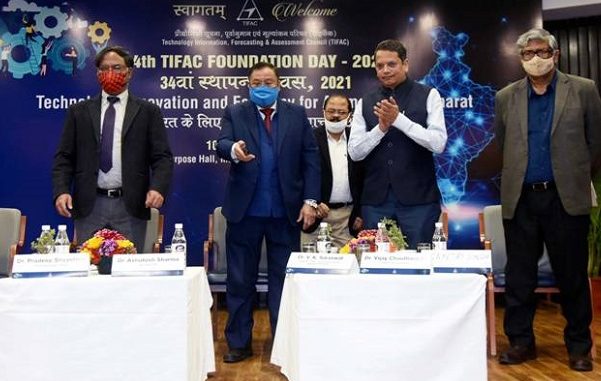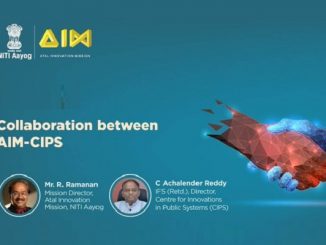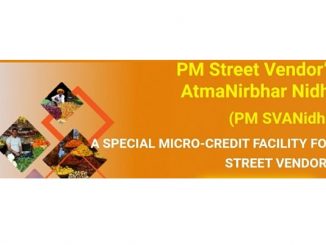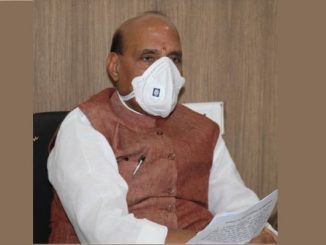
Feb 11: Two new initiatives of Technology Information, Forecasting and Assessment Council (TIFAC) —SAKSHAM (Shramik Shakti Manch)- a dynamic job portal for mapping the skills of Shramiks vis-à-vis requirements of MSMEs to directly connect Shramiks with MSMEs and facilitate placement of 10 lakh blue-collar jobs and a Seaweed Mission for commercial farming of seaweeds and its processing for value addition towards boosting national economy were launched on the occasion of the 34th Foundation Day celebrations yesterday.
Dr V.K. Saraswat, Member Science, Niti Ayog and Chairman-TIFAC, while underscoring the increasing nonlinearity of science in the new era, identified the technological priorities of the future like cyber-physical systems, quantum computing, green chemistry and water. He stressed that it is imperative to focus on technologies that can make India self-reliant or Atmanirbhar and are futuristic as well.
“We should identify those areas where technologies have made breakthrough and bring in indigenous technologies to be independent and globally competent. It is important to make sure we have an eye on the future as well as on the present, and that is where TIFAC’s role comes in a big way,” Dr Saraswat said.
The SAKSHAM job portal will help eliminate middlemen/ labour contractor as well as help identification of skill proficiency level and development of Skill Cards for Shramiks.
Two reports prepared by TIFAC — ‘Techno-economic feasibility on Indian bamboo as Wood Substitute’ and ‘Opportunities for Fruit and Vegetable Processing in North Eastern region of India’ were also launched by Dr Vijay Chauthaiwale, an independent Healthcare consultant.
Here are some details about the two initiatives:
SAKSHAM
SAKSHAM (Shramik Shakti Manch), a dynamic portal for jobs/ mapping the skills of Shramiks vis-à-vis requirements of MSMEs and other industries all across the country. The portal with the demand and supply data uses algorithm and Artificial Intelligence (AI) tools, for geo spatial information on demand and availability of Shramiks, and also provide analysis on skill training programmes of Shramiks. The pilot portal originally initiated with two districts is now being launched as an all India portal.
The portal is now live and can be accessed at www.sakshamtifac.org. The data / information pertaining to the Shramiks and the industries (especially MSME) are being updated automatically through various whatsapp and other links. Efforts are on to popularize these links among the Shramiks and MSMEs all across the country through various channels including social media. Discussions with various state Govts, MSME clusters, etc. are also ongoing.
As the industry contribution to the project, M/s. Sapio Analytics, Mumbai has agreed to give complimentary license of a business automation and accounting software to the MSMEs towards encouraging them to fill up their data and requirements on the portal on a first come first basis. The portal is expected help both Shramiks and MSMEs to take advantage of technology in this era of economic revival. This would empower Sharamiks by projecting their candidature directly to the MSMEs & other employers and would also address aspects related to their skill proficiency levels. This would also eliminate the dependence of industry on the middlemen / labour contractor for their manpower requirements.
The MSME industries have been enlisted from Tamilnadu, Bihar, Maharashtra etc. The list is growing.
Key Features of SAKSHAM:
• A dynamic job portal – opportunity for Shramiks and MSMEs
• Facilitate creation of 10 lakh blue collar jobs
• Direct connect between Shramiks and MSMEs, no middleman in between
• Minimise migration of Shramiks – job opportunity in proximate MSMEs
SEAWEEDS
Out of the global seaweed production of ~ 32 million tons fresh weight valued around 12 billion US dollars. China produces ~57 %, Indonesia ~28% followed by South Korea, whereas India is having a mere share of ~0.01-0.02%. Despite several advantages, commercial seaweeds cultivation has not been taken place in the country at an appropriate scale, as being practiced in South-East Asian countries.
By an estimate, if cultivation is done in ≈10 million hectares or 5% of the EEZ area of India, it can provide employment to ~ 50 million people; set up new seaweed industry; contribute to national GDP; ocean productivity; abates algal blooms, sequesters millions of tons CO2; Healthier ocean; bio-ethanol of 6.6 billion litres
TIFAC Initiatives and proposed Mission Contours
Looking at the immense latent and untapped potential of seaweeds in India, TIFAC had brought out a report on Seaweeds in 2018, which besides highlighting the huge potential also drew out a road map for implementations of the recommendations.
The report, brought out in coordination with CSIR- CSMCRI, Bhavnagar, and other stakeholders like: Central Marine Fisheries Research Institute (CMFRI), CSIR – Central Food Technological Research Institute (CFTRI) and Central Institute of Fisheries Technology (CIFT) also strongly recommended launching a mission on Seaweeds.
This recommendation was discussed in the meeting of the TIFAC Governing Council and it was decided to prepare a Detailed Report for launching the Mission.
The detailed report has now been prepared and finalized in consultation with all the stakeholders namely: CSIR- CSMCRI, Central Marine Fisheries Research Institute (CMFRI), CSIR – Central Food Technological Research Institute (CFTRI) and Central Institute of Fisheries Technology (CIFT).
The Mission envisages the following activities:
• Establishing model demonstration farms over one hectare for cultivation of economically important seaweeds in nearshore and onshore along the Indian coast
• Kappaphycus all over Indian coast
• Gracilaria dura in Gujarat
• Gracilariaverrucosa in Chilka lake (Odhisa)
• Ulva linza or Ulva proliferainChilka lake (Odhisa)
• Ulva lactuca or Ulva fasciata or Ulva indica all over India coast
Proposed Demonstration Sites:Gujarat / Tamil Nadu / Andhara Pradesh / Odisha / Karnataka
Stakeholder Organizations: CSMCRI,
• Establishment of seaweed nurseries for supplying seed material for large scale farming of economically important seaweeds in the country
• Ulva (spore-based methods or vegetative as applicable)
• Kappaphycus and Gracilaria (vegetative methods)
Demonstration Site: along the proposed cultivation sites and leveraging the available infrastructure Gujarat/Tamil Nadu/Odisha/Karnataka/Andhra Pradesh
Onshore cultivation for (i) Seedling supply facility (ii) Seaweed cultivation for processing
• Establishment and demonstration of processing technologies/recipes for edible seaweeds in line with consumer acceptability or cultural food habits
• Dried flakes, Dried powder, Dried sheets or processed dried sheets with additional flavour meeting the acceptance/perceptions of people
• Seaweed-based proteins as an alternate to meet
• Food supplements
• Feed supplements
Setting up of processing plant for integrated production of plant growth stimulants (sap) along with industrially important cell wall polysaccharides (phycocolloids) such as agar, agarose, carrageenan and alginates from fresh seaweeds
• Sap
• Polysaccharides (Ulvan, agar, agarose, carrageenan and alginates)
• Value addition technologies aimed at making high value products for niche markets (personal care, cosmetics, nutraceuticals, feed supplements)
Specific Zones Identified: East & West Coast
• An activity on seaweed cluster development including value chain development, supply chain development, collection of data on environmental, economic and social impacts of seaweed projects in the country.
Implementing Organisation: TIFAC
Stakeholder/ Supporting agencies: CSIR labs (CSMCRI, CFTRI, etc) ICAR labs (CMFRI, CIFT, etc.) and State Fisheries Departments
TIFAC’s role would be to network and orchestrating the operations, demonstrating farming, nucleating value addition products, support policy changes and advice on regulatory issues, market control, etc.
Methodology
• Technology demonstration for commercial farming of seaweeds in the country
• Technology demonstration for processing of seaweeds for value-added products
Potential
• Scope for attracting overseas investments in Indian seaweed sector
• Got potentials to contribute to the ‘AatmaNirbhar Bharat Abhiyaan’
SAKSHAM
Saksham is a dynamic portal for mapping the skills of Shramiks vis-à-vis requirements of MSME and other industries all across the country. The portal with the demand and supply data uses Agenda for the 54th Meeting of TIFAC Governing Council- 28.01.2021 11 algorithm and logic being integrated with the system along with various Artificial Intelligence (AI) tools, so that it would not only provide geo spatial information on demand and availability of Shramiks, but would also provide analysis on skill match, skill gaps, recommendations on skill training programmes, etc. The portal is now live and can be accessed at sakshamtifac.org. The data / information pertaining to the shramiks and the industries (especially MSME) are being updated automatically through various whatapp and other links. Efforts are on to popularize these links among the shramiks and MSMEs all across the country through various channels including social media. Discussions with various state Govts, MSME clusters, etc. are also ongoing. As the industry contribution to the project, M/s. Sapio Analytics, Mumbai has agreed to give complimentary license of a business automation and accounting software to the MSMEs towards encouraging them to fill up their data and requirements on the portal on a first come first basis. The portal is expected help both Shramiks and MSMEs to take advantage of technology in this era of economic revival. This would empower Sharamiks by projecting their candidature directly to the MSMEs & other employers and would also address aspects related to their skill proficiency levels. This would also eliminate the dependence of industry on the middlemen / labour contractor for their manpower requirements.
Disclaimer: We donot claim that the images used as part of the news published are always owned by us. From time to time, we use images sourced as part of news or any related images or representations. Kindly take a look at our image usage policy on how we select the image that are used as part of the news.


